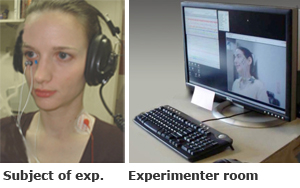

Typical eye blink startle response shown in the upper (red) trace, following a 40mS acoustic startle probe shown in the lower (blue) channel.

Experiment set-up with stimulus screen for viewing pictures or movie clips.
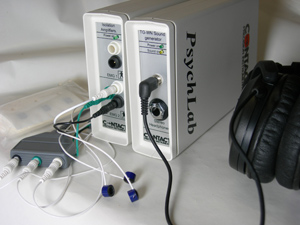
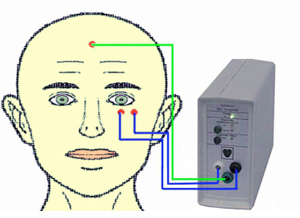
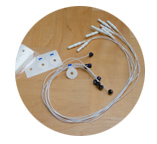
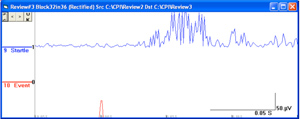
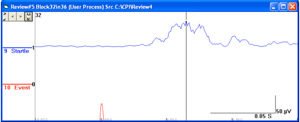
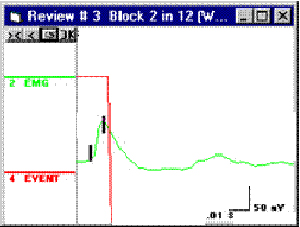
STARTLE - BLINK
Designing the experiment
Positioning the subject
Psychlab equipment required
Applying the electrodes
Startle data analysis
Alternative methods of blink detection
Eye blink startle response is a robust CNS test, used widely in psychophysiology. PsychLab accommodates complex experiment designs, including pre-pulse inhibition and affective modulation using emotional pictures presented on a computer screen (e.g. IAPS).
Typical eye blink startle response shown in the upper (red) trace, following a 40mS acoustic startle probe shown in the lower (blue) channel.
DESIGNING THE EXPERIMENT
PsychLab measuring software allows other measures to be mixed with startle blink. Often Skin Conductance and Heart Rate are also measured, providing additional information for each trial when data are analyzed.
The subject may be positioned behind a screen or in another room, and a synchronized video image can be stored on the hard drive.
If pictures or video are to be shown for stimulus, a second monitor can be attached to the computer using windows ‚"extended desktop" mode, which allows one program to show different things on the two monitors.
The PsychLab program allows pictures to be loaded in groups and shown in chosen sequence. Intelligent script allows choice of picture type, picture timing, probe delay, probes in the inter trial interval (ITI), and so on to be designed so that correctly weighted trial distribution is achieved. Pseudo random and true random functions may be used. For fear conditioning, the PsychLab shocker can provide UCS.
Auditory startle ‚"probe" is most commonly used - a short burst of noise (40 or 50 mS duration at 80-110dB provided by the PsychLab TG-WN sound generator. Alternative probe modalities are light flash, electro-cutaneous stimulation, or air puff.
POSITIONING THE SUBJECT
Best results are achieved if the subject is positioned at a distance from the computer. The EMG Amplifier and the TG-WN stimulator may be placed near to the subject using extension USB cables if required. If a video monitor is required as part of the stimulation protocol, it may be positioned on a table close enough for the subject to view but it should not be placed immediately adjacent to the PsychLab amplifiers.
PSYCHLAB EQUIPMENT REQUIRED
Equipment required for a minimal startle system:
| PSYCHLAB EQUIPMENT | |
| 1 EMG 1 TG-WN 1 PHON 1 EL123 1 CL31 1 PSY |
EMG amplifier Sound generator Headphones Set of EMG electrodes Long input lead PsychLab software |
APPLYING THE ELECTRODES
Two 4mm diameter measuring electrodes (part no EL123) may be positioned below the eye, 12mm to 36mm apart, ideally 25mm. Suitable adhesive collars are supplied with these re-usable electrodes. Greater distance between the electrodes lowers the upper bandwidth of EMG energy. It may be necessary to trim the collars to allow the electrodes to be positioned close together, as the collar diameter is about 15mm. Peel off the backing from one side of the collar and stick it onto the electrode so that it does not obscure the active area of the electrode. Then fill the electrode with jell, so that the jell is flush with the electrode/collar surface. Wipe away excess jell, then peel off the other surface of the collar, taking care not to get jell on the sticky surface. Wipe the skin where the electrode is to be placed to remove any grease, then apply the electrode to the skin, pressing firmly so that it sticks in position. It must be well enough attached to remain in position for the duration of the procedure. It does not matter which of the two electrodes is plugged into which of the white and black sockets of the amplifier. A third electrode must then be similarly attached to the centre of the forehead and plugged into the green (isolated ground) socket of the amplifier.
STARTLE DATA ANALYSIS
During the experiment, data are continuously recorded to disk. This allows complete flexibility when analyzing data, as any part of the record can be accessed should it be decided to modify the analysis after the recording has been made. Continuous measurement mode is also very helpful in accommodating other measures such as SC and HR, which require much wider time periods for analysis purposes. When data are reviewed, trials are identified by stimulus type, as recorded in the event channel while the experiment took place. A 100mS window of data (block) is taken from probe onset for each trial. This is then rectified and integrated, such that a blink wave is produced.
More information on rectification and integration of EMG is found in the EMG section of this site.
Blink amplitude may then be obtained using the PsychLab wave detection algorithm, which produces the black markers as seen positioned on the green EMG trace. This information may then be used to obtain blink amplitude and blink magnitude figures for each category of stimulus.
Some standard startle equations that may be applied to data obtained in grand trial categories are:
| STARTLE EQUATIONS | |
| Magnitude of blink= | Total amplitude of all responses in all trials total number of trials |
| Amplitude of blink = | Total amplitude of all trials where there is a response number of trials in which there was a response |
ALTERNATIVE METHODS OF BLINK DETECTION
There are alternative methods for assessing blink amplitude and onset latency, instead of using the wave algorithm, such as to take an average of pre-stimulus EMG, multiply it by a factor and using this value as a criterion for determining blink onset. PsychLab can accommodate this with more complex setting up of the macro script facility.
